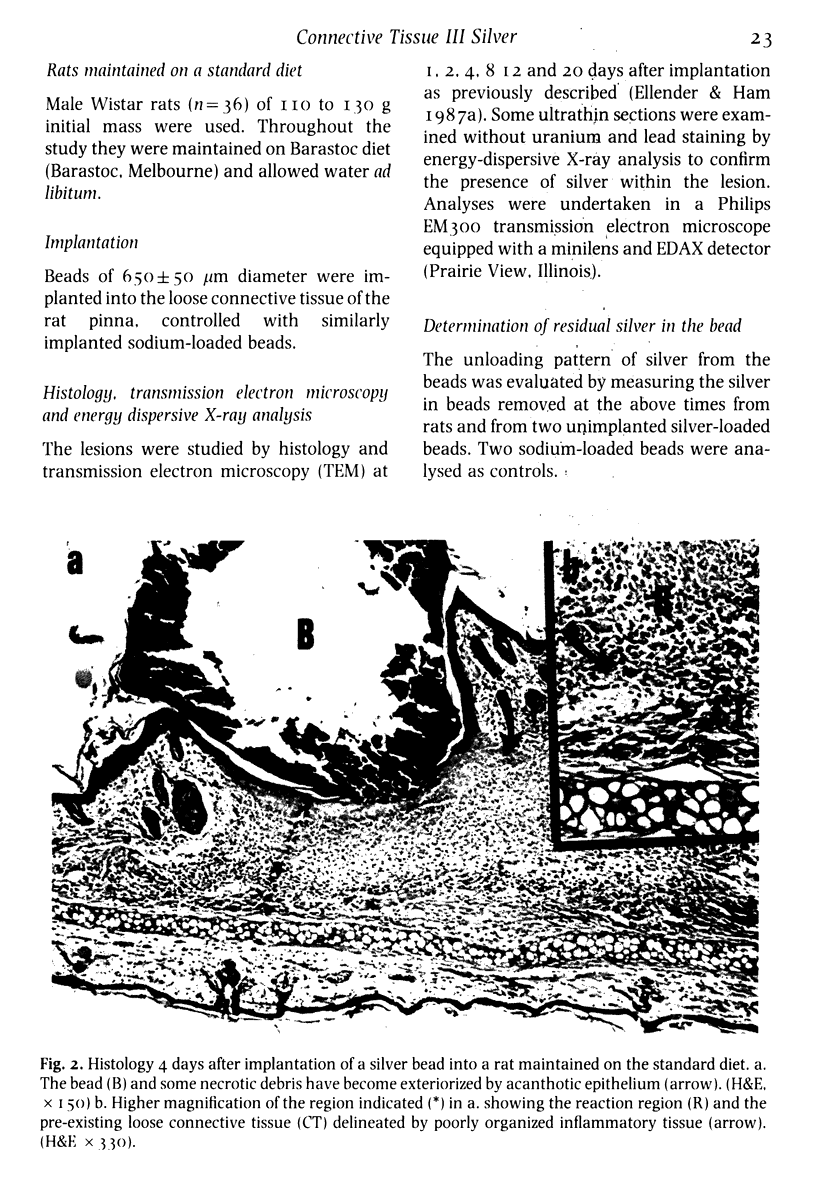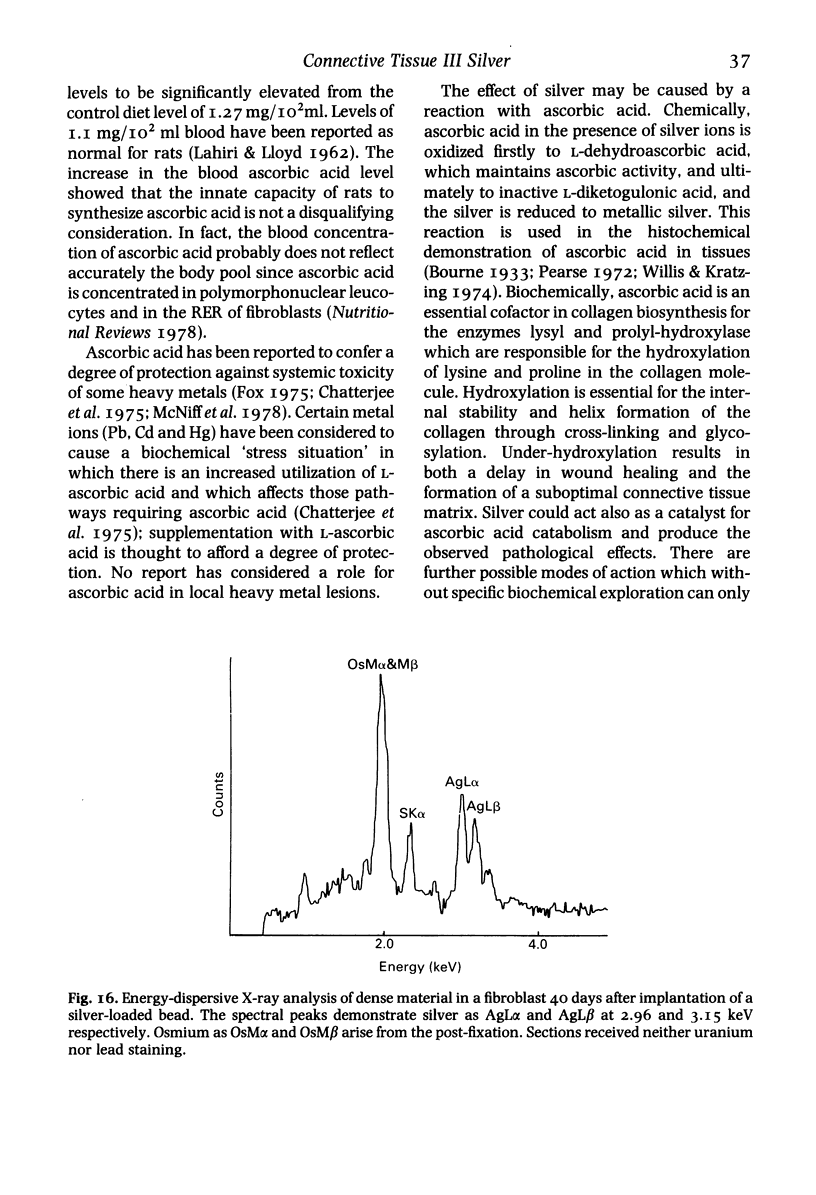Abstract
Silver-loaded ion exchange resin beads implanted into loose connective tissue of the rat pinna produced a local reaction. Initially the lesion comprised local necrosis and tissue disruption with predominantly small round cell infiltration. The subsequent organization was delayed and disordered. Fibroblasts developed grossly dilated cisternae of the rough endoplasmic reticulum. The matrix contained poorly orientated collagen fibrils of varying size and ground substance appeared condensed and granular. Distorted collagen fibrils were identified within membrane-bound vacuoles in the cytoplasm of both fibroblasts and macrophages. Abnormalities of the silver lesion were indicative of disordered collagen biosynthesis. Silver interfered with the biosynthesis and assembly of matrix components of the connective tissue. The reaction to silver beads in rats maintained on a diet heavily supplemented with ascorbic acid approached that of the control (sodium-loaded bead) with respect to the time scale, tissue reaction and tissue organization. The collagen matrix which formed was more organized and of greater density than that in the rat maintained on a normal diet. However, the repair tissue retained some of the morphological features of the legacy of silver toxicity, in particular delayed repair and dense intracellular fibrils within fibroblasts and macrophages. The excess of ascorbic acid partially ameliorated the effect of silver, possibly by compensating catabolysis of ascorbic acid caused by the presence of the released silver.
Full text
PDF


















Images in this article
Selected References
These references are in PubMed. This may not be the complete list of references from this article.
- Comper W. D., Laurent T. C. Physiological function of connective tissue polysaccharides. Physiol Rev. 1978 Jan;58(1):255–315. doi: 10.1152/physrev.1978.58.1.255. [DOI] [PubMed] [Google Scholar]
- Dunstone J. R. Ion-exchange reactions between acid mucopolysaccharides and various cations. Biochem J. 1962 Nov;85(2):336–351. doi: 10.1042/bj0850336. [DOI] [PMC free article] [PubMed] [Google Scholar]
- Ellender G., Ham K. N. Connective tissue responses to some heavy metals. I. Sodium loaded ion exchange beads as a control: histology and ultrastructure. Br J Exp Pathol. 1987 Jun;68(3):277–289. [PMC free article] [PubMed] [Google Scholar]
- Ellender G., Ham K. N. Connective tissue responses to some heavy metals. II. Lead: histology and ultrastructure. Br J Exp Pathol. 1987 Jun;68(3):291–307. [PMC free article] [PubMed] [Google Scholar]
- Fox C. L., Jr, Modak S. M., Stanford J. W. Zinc sulfadiazine for topical therapy of pseudomonas infection in burns. Surg Gynecol Obstet. 1976 Apr;142(4):553–559. [PubMed] [Google Scholar]
- Fox M. R. Protective effects of ascorbic acid against toxicity of heavy metals. Ann N Y Acad Sci. 1975 Sep 30;258:144–150. doi: 10.1111/j.1749-6632.1975.tb29274.x. [DOI] [PubMed] [Google Scholar]
- HILL C. H., STARCHER B., MATRONE G. MERCURY AND SILVER INTERRELATIONSHIPS WITH COPPER. J Nutr. 1964 Jun;83:107–110. doi: 10.1093/jn/83.2.107. [DOI] [PubMed] [Google Scholar]
- Hirashita A., Noda K., Kaida K., Nakamura Y., Kuwabara Y. Phagocytosis of collagen by fibroblasts incident to experimental tooth movement. Arch Histol Jpn. 1985 Apr;48(2):149–158. doi: 10.1679/aohc.48.149. [DOI] [PubMed] [Google Scholar]
- LAHIRI S., LLOYD B. B. The effect of stress and corticotrophin on the concentrations of vitamin C in blood and tissues of the rat. Biochem J. 1962 Sep;84:478–483. doi: 10.1042/bj0840478. [DOI] [PMC free article] [PubMed] [Google Scholar]
- Levine M. New concepts in the biology and biochemistry of ascorbic acid. N Engl J Med. 1986 Apr 3;314(14):892–902. doi: 10.1056/NEJM198604033141407. [DOI] [PubMed] [Google Scholar]
- Mason K. E. A conspectus of research on copper metabolism and requirements of man. J Nutr. 1979 Nov;109(11):1979–2066. doi: 10.1093/jn/109.11.1979. [DOI] [PubMed] [Google Scholar]
- McNiff E. F., Cheng L. K., Woodfield H. C., Fung H. L. Effects of L-cysteine, L-cysteine derivatives and ascorbic acid on lead excretion in rats. Res Commun Chem Pathol Pharmacol. 1978 Apr;20(1):131–137. [PubMed] [Google Scholar]
- Peterson R. P., Jensen L. S. Interrelationship of dietary silver with copper in the chick. Poult Sci. 1975 May;54(3):771–775. doi: 10.3382/ps.0540771. [DOI] [PubMed] [Google Scholar]
- ROSS R., BENDITT E. P. Wound healing and collagen formation. II. Fine structure in experimental scurvy. J Cell Biol. 1962 Mar;12:533–551. doi: 10.1083/jcb.12.3.533. [DOI] [PMC free article] [PubMed] [Google Scholar]
- Trelstad R. L. Glycosaminoglycans: mortar, matrix, mentor. Lab Invest. 1985 Jul;53(1):1–4. [PubMed] [Google Scholar]
- Van Campen D. R. Effects of zinc, cadmium, silver and mercury on the absorption and distribution of copper-64 in rats. J Nutr. 1966 Jan;88(1):125–130. doi: 10.1093/jn/88.1.125. [DOI] [PubMed] [Google Scholar]
- Whanger P. D., Weswig P. H. Effect of some copper antagonists on induction of ceruloplasmin in the rat. J Nutr. 1970 Mar;100(3):341–348. doi: 10.1093/jn/100.3.341. [DOI] [PubMed] [Google Scholar]
- Willis R. J., Kratzing C. C. The chemistry of the silver precipitation method used for the histochemical localization of ascorbic acid. Stain Technol. 1974 Nov;49(6):381–386. doi: 10.3109/10520297409117015. [DOI] [PubMed] [Google Scholar]
- Ziffren S. E. Results of the treatment of burns with silver nitrate. Ann N Y Acad Sci. 1968 Aug 14;150(3):946–949. doi: 10.1111/j.1749-6632.1968.tb14746.x. [DOI] [PubMed] [Google Scholar]
















